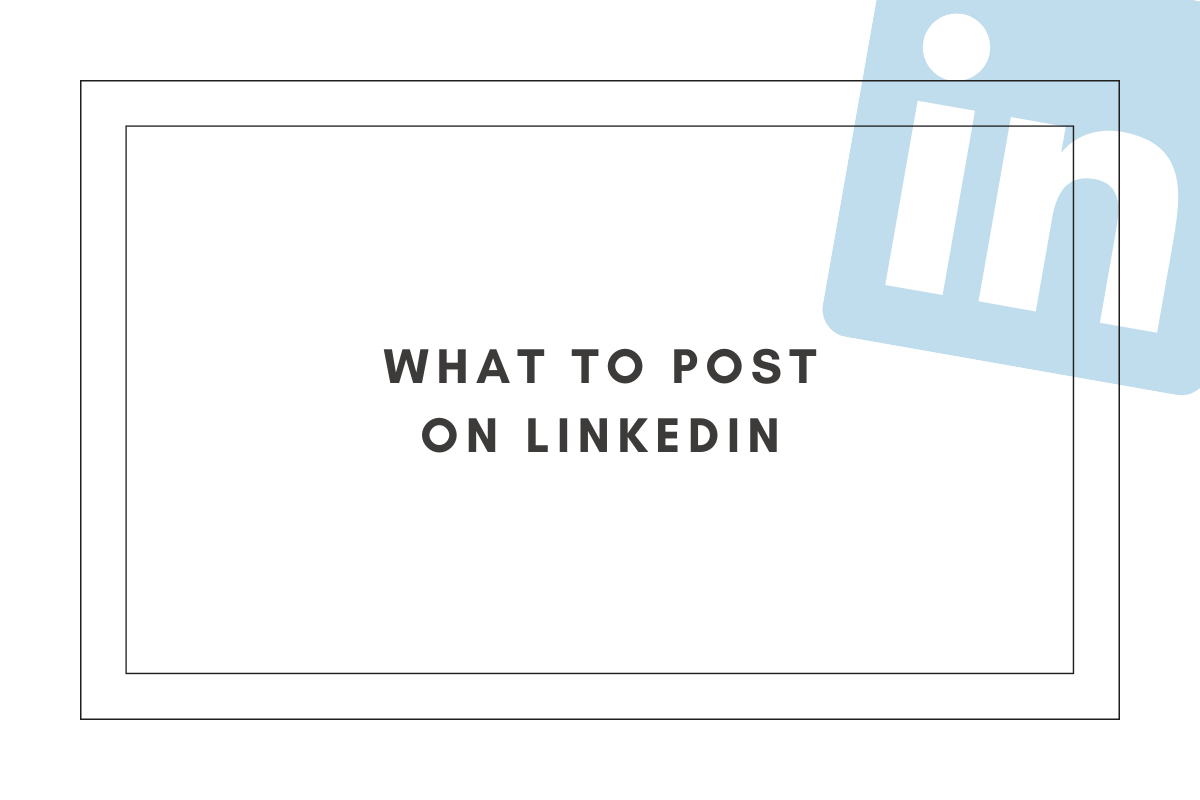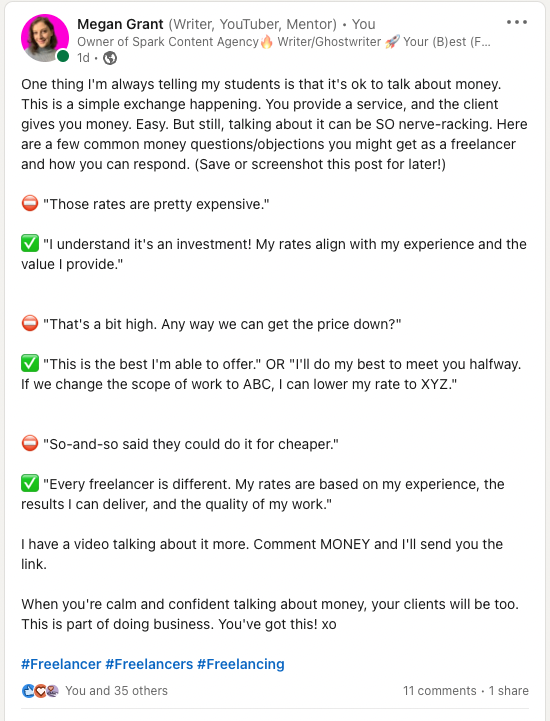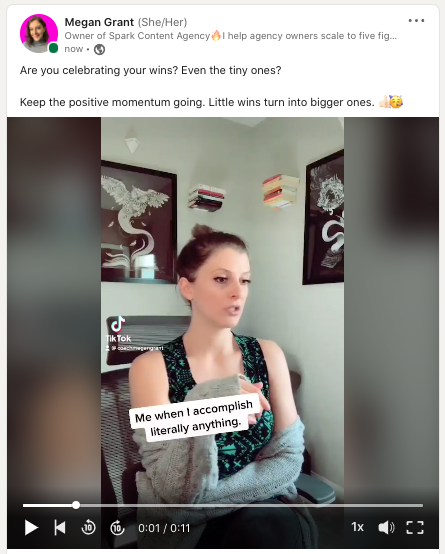Part of expanding your reach and growing your engagement on LinkedIn is posting content that people will love. But what does this look like? Let’s talk about what to post on LinkedIn (as well as go through a few LinkedIn post examples) so that your connections and followers will want to engage with you.
Psst! If you prefer video over text, I’ve got you covered.
BTW, if this blog is up your alley, you might also enjoy reading about my ninja LinkedIn post tips.
What to Post on LinkedIn to Get People’s Attention
Let’s start at the beginning.
When it comes to social networking, one of our biggest tendencies is to talk about ourselves. And that’s understandable. After all, it’s your LinkedIn page.
However, this approach will land you dead in the water.
The first thing you need to understand is that your LinkedIn posts should not be all about you. In fact, most of them shouldn’t be about you. They should be about your audience.
Who are you trying to reach? Who are your dream clients? That’s who you’re speaking to.
So, you need to start by asking yourself, “What do these people need? What do they care about? What are their struggles and pain points and goals?”
This is going to heavily influence your LinkedIn posts.
Jot down these points and have them in front of you when you’re posting on the platform so that you can double-check that the content you’re sharing speaks to these people.
Now, when it comes to exactly what to post on LinkedIn, there are three general types of content that your posts will fall into:
- Information
- Entertainment
- Anecdotes
Let’s talk about each of these, as well as go through some LinkedIn post examples.
Information
Information is content that teaches them something. If you check out my LinkedIn page — send me an invite and tell me you found me on my blog! — you’ll see that most of what I post is informational. I’m offering tips and tricks and hacks for my target audience. Here’s one example from my page:
Because the students who enroll in my program, Revenue Spark, are overwhelmingly freelancers, I’m speaking to them. In this example, I’m helping them understand how they can more confidently talk about money.
The reason informational posts are so powerful is that they provide value. And providing value is a really effective way to help your target audience get to know, like, and trust you. You’re establishing yourself as an authority and expert.
In order to grow your audience, you have to give before you can take. I know it’s tempting to just hard sell and only talk about your services. But this approach doesn’t work. Understandably, you might be thinking, “Well, if I use my LinkedIn posts to help people, they have no need to hire me.” But do you really think you’re going to tell them everything they need to know on LinkedIn? No.
That’d be like me saying that I could fit the entirety of Revenue Spark into a couple of LinkedIn posts, and therefore, people won’t want to enroll. It’s just not going to happen.
Rather, you’re giving them little nuggets of information that will have them coming back for more.
That’s information.
Entertainment
The second type of content is entertainment. Entertainment doesn’t necessarily teach your audience anything. Rather it might inspire them, motivate them, make them laugh, or make them think.
Sometimes, I’ll post motivational quotes on LinkedIn, or I’ll repurpose a silly video that I originally posted to TikTok. It’s still relevant to my target audience but I’m not giving them tips or tricks.
Anecdotes
The third type of LinkedIn post that you can share is anecdotes — stories of things that actually happened to you or someone you know.
In my LinkedIn posts, I talk a lot about my experience as a freelancer and then building an agency, mistakes I’ve made, and what I’d do differently if I were to go back in time. I share my personal experiences and things I’ve been through, which are relevant to my audience.
As you might’ve already seen, there is some overlap between these three types of LinkedIn posts. A post that’s informational can also be entertaining or an anecdote or some combination of the three, and that’s great.
I want to reiterate, though, that regardless of what type of post you’re sharing, it needs to provide some sort of value. A simple way to figure out if you’re doing this is to ask yourself, “What does my audience get out of this post?” If you can’t answer that, you might want to revise your content.
Breaking down what to post on LinkedIn is something I teach in Revenue Spark. Now, after getting through these lessons, a lot of my students will ask me, “Wait, so does that mean I can’t talk about my business on LinkedIn? I can’t sell my services?”
You can, and you should… in the context of content that is informational, entertaining, or anecdotal.
I have completely eliminated LinkedIn posts that straight-up say, “Enroll in my program!” or “Hire my content agency!” Who cares? No one cares. They get nothing out of that type of post.
Instead, I might share a success story about one of my students, who landed his first two clients within three weeks of enrolling in Revenue Spark. And then at the end of that post, I’ll say something like, “If you’re interested in learning how he did it, drop a comment or DM me to talk more.”
So, I’m still promoting my offerings, but I’m doing it by providing value.
Don’t forget that you want to include hashtags in your LinkedIn posts. I’ve got a video on that:
Remember that when you make it your goal to serve your audience, the LinkedIn universe will reward you tenfold.
If you want to learn how I’ve used LinkedIn and a few other tools to scale my own agency to nearly $20,000 a month, learn more about Revenue Spark and book a call with me today.


